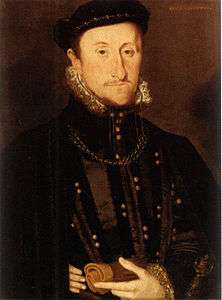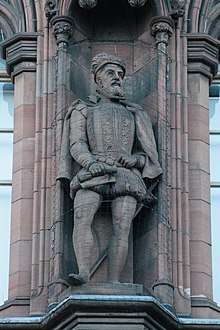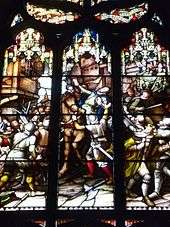James Stewart, 1st Earl of Moray
James Stewart, 1st Earl of Moray (c. 1531 – 23 January 1570),[1] a member of the House of Stewart as the illegitimate son of King James V, was (from 1567 until his assassination in 1570) the Regent of Scotland for his half-nephew, the infant King James VI. He was the first head of government to be assassinated by a firearm.
James Stewart, 1st Earl of Moray Regent of Scotland | |
|---|---|
 The Earl of Moray, a detail from a wedding portrait by Hans Eworth | |
| Born | c. 1531 Scotland |
| Died | 23 January 1570 Linlithgow, Scotland |
| Buried | St. Giles Cathedral, Edinburgh |
| Spouse(s) | Christina Stewart Agnes Keith |
| Issue
Elizabeth Stewart, 2nd Countess of Moray Annabel Stewart Margaret Stewart | |
| Father | King James V of Scotland |
| Mother | Lady Margaret Erskine |
| Religion | Calvinist |

Early life
Moray was born in about 1531, the most notable of the many illegitimate children of King James V of Scotland. His mother was the King's favourite mistress, Lady Margaret Erskine, daughter of John Erskine, 5th Lord Erskine,[2] and wife of Sir Robert Douglas of Lochleven. On 31 August 1536 he received a royal charter granting the lands of Tantallon and others. James was appointed Prior of St Andrews, Fife, in his childhood in 1538.[3] This position supplied his income.
Rises in power, advises Queen Mary
As early as May 1553, the imperial ambassador to England, Jean Scheyfve, heard that Mary of Guise planned to make him Regent of Scotland in place of James Hamilton, Duke of Châtellerault.[4]
On 5 August 1557, Moray, his half-brother Lord Robert, and Lord Home led a raiding party from Edinburgh towards Ford Castle in Northumberland and burnt houses at Fenton, before retreating on the approach of an English force led by Henry Percy.[5] James attended the wedding in Paris in 1558 of his legitimate half-sister, Mary, Queen of Scots, to the Dauphin of France, who became King Francis II. To fund this trip his mother obtained credit from Timothy Cagnioli, an Italian banker in Edinburgh.[6]
James became a supporter of the Scottish Reformation. At Perth, Scotland in June 1559 he plucked down the images in various churches.[7] An English commentator praised James for his virtue, manhood, valour and stoutness as a leader of the Protestant Lords of the Congregation.[8]
Despite their religious differences, Moray became one of the chief advisers to his sister, Mary, Queen of Scots, in 1561 after her return from France. She was the only surviving child of his father's marriage to Mary of Guise. Although James disturbed her priests celebrating mass at Holyroodhouse in September 1561,[9] she made him Earl of Moray and Earl of Mar (the Mar earldom was soon afterwards withdrawn)[10] the following year, both earldoms being new creations.[11] With the lucrative Moray earldom came Darnaway Castle with its medieval hall, notable even then as "verie fayer and large builded." Moray also had a smaller house called Pitlethie near Leuchars in Fife, which his father had used.[12]
In October 1562, Moray defeated a rebellion by George Gordon, 4th Earl of Huntly, at the Battle of Corrichie near Aberdeen. The theretofore very powerful and wealthy Huntly, who controlled large areas of northeastern Scotland, died immediately after this battle.[10] Moray opposed the marriage of Mary, Queen of Scots, to Lord Darnley in 1565, and he embarked upon the unsuccessful Chaseabout Raid, together with the Earl of Argyll and Clan Hamilton. He was subsequently declared an outlaw, and took refuge in England. Returning to Scotland after the murder of David Rizzio, he was pardoned by the Queen,[2] and once more became one of her key advisers. He contrived, however, to be away at the time of Darnley's assassination in 1567, and avoided the tangles of Mary's subsequent marriage with James Hepburn, 4th Earl of Bothwell, which followed the Darnley murder by mere weeks, by going to France.[2]
The Gude Regent
.jpg)
Mary was forced into abdication at Loch Leven Castle on 24 July 1567, where she was imprisoned for some ten months (1567–1568).[10] Moray returned to Edinburgh from France on 11 August 1567, escorted from Berwick-upon-Tweed by James Melville of Halhill, with a French ambassador, De Lignerolles. William Cecil, the English secretary of State had arranged his transport from Dieppe in an English ship.[13] He was appointed Regent of Scotland on 22 August, for the minority infant King James VI (born 1566), son of Queen Mary and Lord Darnley.[14] The appointment was confirmed by Parliament in December. To raise money Moray sent his agent Nicolas Elphinstone to London to sell Mary's jewels and pearls.[15]
Mary escaped from Lochleven on 2 May 1568, and the Duke of Chatelherault and other nobles rallied to her standard. Moray gathered his allies and defeated her forces at the Battle of Langside, near Glasgow on 13 May 1568.[2] Mary was compelled to flee, and decided to go to England; she could have equally have departed for France, although this would have taken more time and resources to arrange.[10] For this and the subsequent management of the kingdom he secured both civil and ecclesiastical peace, and earned the title of "The Gude Regent".[16]
York conference
In September 1568, Moray chose commissioners and went to York, to discuss a treaty with England. During this conference he produced the casket letters, which were supposed to incriminate Queen Mary, and justify his rule in Scotland. It was later said that a plan to assassinate him at Northallerton, Yorkshire, on his way back had been called off.[17]
Military activities
Scotland was now in a state of civil war. Moray moved against the supporters of Queen Mary in their south-west homelands with a military expedition in June 1568 called the 'Raid of Dumfries' or 'Raid of Hoddom.' The Regent's army and the royal artillery was taken to Biggar, where his allies were commanded to muster on 10 June, and on to Dumfries. The army was protected by a scouting party led by Alexander Hume of Manderston, the vanguard was commanded by the Earl of Morton and Lord Hume. Behind was the 'carriage', the artillery train, followed by Moray himself. The Laird of Cessford followed behind, and the army was flanked by the scouting parties of the Lairds of Merse and Buccleuch.[18]
Along the way, Moray captured houses belonging to supporters of Queen Mary, including Lord Fleming's Boghall, Skirling, Crawford, Sanquhar, Kenmure, and Hoddom where the cannon were deployed, and Annan where he rendezvoused with Lord Scrope the Captain of Carlisle Castle to discuss border matters. Scrope estimated the army to number 6,000 men, and returned to Carlisle where he saw Queen Mary's servants play football on 14 June. Moray then took Lochmaben Castle, which the Laird of Drumlanrig was left to hold, and then captured Lochwood and Lochhouse before returning to Edinburgh via Peebles. At Dumfries, a number of Lord Maxwell's supporters surrendered.[19] Moray was responsible for the destruction of Rutherglen castle, which he burned to the ground in 1569 in retribution against the Hamiltons for having supported Mary at the Battle of Langside.[20]
In June 1569 Moray went north to Brechin where he accepted hostages sent by the Earl of Huntley, then at Dunnotar Castle he proclaimed that he had, "reparit (arrived) in proper person (as Regent) to thir north partis of firm purpose and deliberation to reduce sic as hes neglectit their duty in time bypast ..., intending to use lenitie (leniency) and moderation."[21]
At Aberdeen Moray held talks with Huntly himself. At Inverness, on 4 June 1569, Moray met the Highland and Island chiefs with the Earls of Caithness and Sutherland and Lord Lovat. His secretary, John Wood, said "such a power had seldom been seen there," Moray wrote that "the journey is to put down troubles in the north."[22]
Marriage and family
- Christina Stewart, 4th Countess of Buchan (c. 1548 – 20 September 1580), In January 1549/50, though Christina was only a young child, a contract of marriage was arranged between her and James Stewart, afterwards Earl of Moray and Regent, which would give him possession of her lands.
- Agnes Keith (c.1540 – 16 July 1588), On 8 February 1561/2 at Holyrood,[23] Moray married Agnes Keith, daughter of William Keith, 4th Earl Marischal. The marriage produced three daughters:[24]
- Elizabeth Stuart, 2nd Countess of Moray (Aug 1565[25] – 18 November 1591), married James Stewart, 2nd Earl of Moray on 23 January 1580/1581
- Lady Annabel Stuart (? – before 1572)
- Lady Margaret Stuart (8 Apr 1569 – 1586), contract for the marriage signed on 27 June 1584 with Francis Hay, 9th Earl of Erroll, without issue.[24]
Assassination

On Thursday 19 January 1570 Moray was at Stirling Castle where he had invited the English diplomat Sir Henry Gates and the soldier Sir William Drury, Marshal of Berwick, for dinner in the Great Hall. Later in his bedchamber he told the English visitors he would meet them and certain Scottish nobles at Edinburgh on Monday or Tuesday to discuss the rendition of English rebels. Moray was troubled by the problem of Dumbarton Castle, which was held against him by supporters of Mary, Queen of Scots.[26] On 21 January, he sent letters to summon the Earl of Morton, Lindsay and Home to the meeting in Edinburgh.[27]
Moray was assassinated in Linlithgow on 23 January 1570 by James Hamilton of Bothwellhaugh, a supporter of Mary. As Moray was passing in a cavalcade in the main street below, Hamilton fatally wounded him with a carbine shot from a window of his uncle Archbishop Hamilton's house.[28] He was the first head of government to be assassinated by a firearm.[29]
Moray's body was shipped to Leith, then taken to Holyrood Abbey.[30] Moray was buried on 14 February 1570 in St Anthony's aisle at St Giles' Cathedral, Edinburgh. Seven earls and lords carried his body; William Kirkcaldy of Grange held his standard, and John Knox preached at the funeral.[30] Knox's own prohibition of funeral sermons (on the grounds that they glorified the deceased and displayed distinctions between rich and poor) was waived for the occasion.[31] Moray's tomb was carved by John Roytell and Murdoch Walker, with a brass engraved by James Gray.[32] The contract for the tomb survives, and was written by the chaplain Robert Ewyn, the administrator of the craft of masons and wrights in Edinburgh.[33]
His wife, Agnes Keith, was buried inside his tomb when she died in 1588.[34]
Moray was succeeded by his eldest daughter and heir, Elizabeth Stewart, 2nd Countess of Moray, whose husband, James Stewart of Doune acquired the earldom on their marriage.
Cultural depictions
A stained glass window installed in St. Giles' Cathedral, Edinburgh, in the 1880s depicts Moray's assassination and John Knox preaching at his funeral.[35] There is a bas-relief sculpture by Amelia Hill in Linlithgow commemorating the assassination, and a Regent Moray Street next to the Kelvin Hall in Glasgow.
The Earl of Moray is depicted in many fictional works which focus on the life and times of Mary, Queen of Scots. These include:
- Sir Walter Scott's 1820 novel The Monastery (where he is identified as the "Earl of Murray")[36]
- The 1923 film The Loves of Mary, Queen of Scots where he is portrayed by Lionel d'Aragon
- The 1936 film Mary of Scotland where he is portrayed by Ian Keith
- The 1940 film Das Herz der Königin where he is portrayed by Walther Suessenguth
- The 1971 film Mary, Queen of Scots (where he is portrayed by Patrick McGoohan)[37]
- Thea Musgrave's 1977 opera Mary, Queen of Scots[38]
- The 2013–2017 television series Reign (in which he is portrayed by Dan Jeannotte)[39]
- The 2018 film Mary Queen of Scots in which he is portrayed by James McArdle
References
| Wikimedia Commons has media related to James Stewart, Earl of Moray. |
- Spottiswoode, John, History of the Church in Scotland, vol. 2, Oliver & Boyd (1851), 120 gives date in Old Style as Saturday 23 January 1569/70, although Saturday was 21 January in that year, see Reference calendar: Loughlin, Mark, 'Stewart, James, first earl of Moray (1531/2–1570)', Oxford Dictionary of National Biography, Oxford University Press, 2004 accessed 24 Jan 2011 accepts 23 January: Fraser, Antonia, Mary, Queen of Scots, p. 486 (p. 421 English edition) has 11 January 1570 as date of the assassination. Also mentioned by Alison Weir, Britain's Royal Family: The Complete Genealogy (London, U.K.: The Bodley Head, 1999), page 242.
-

- Sir James Balfour Paul, The Scots Peerage: founded on Wood's edition of Sir Robert Douglas's The Peerage of Scotland (Edinburgh, Scotland: David Douglas, 1904), volume I, page 23.
- Calendar of State Papers Spanish, vol. xi, (1916), 41–2.
- Strype, John, Ecclesiastical Memorials, vol. 3 part 2, (1822), 67–9.
- Cameron, Annie I., ed., Scottish Correspondence of Mary of Lorraine, (1927), 411, total £1687-10s Scots.
- Calendar State Papers Scotland, vol. 1 (1898), 216.
- Calendar of State Papers Scotland, vol. 1 (1898), 362, Randolph to Killigrew, 15 April 1560.
- Calendar State Papers Scotland, vol. 1 (1898), 555.
- Fraser, Antonia Mary, Queen of Scots, 1969
- Alison Weir, Britain's Royal Family: A Complete Genealogy (London, U.K.: The Bodley Head, 1999), page 242.
- Calendar of State Papers Scotland, vol. 1 (1898), 655: vol. 2 (1900), 2: Graves, Andrea, Princlie Majestie', John Donald (2005), 52
- Stevenson, Joseph, ed., Selections from Unpublished Manuscripts, Maitland Club (1837), pp.200–1, 269–271: Calendar State Papers Scotland, vol. 2 (London, 1900), pp. 380–1 no.595
- Sir James Balfour Paul, Scots Peerage, vol. 1 (Edinburgh, 1904), p. 23.
- Historical Manuscripts Commission 6th Report: Earl of Moray, p. 643.
- Birrel's diary, quoted in Chambers, Robert, Domestic Annals of Scotland, vol. 1 (Edinburgh, 1858), p. 60.
- Murdin, William, ed., Collection of State Papers (London, 1759), p. 51.
- Calendar State Papers Scotland, vol. 2 (Edinburgh, 1900), p. 446 no. 717.
- Accounts of the Treasurer of Scotland, vol. 12 (Edinburgh, 1970), 128–134: Holinshed, Raphael, Chronicles: Scotland, vol. 5 (London, 1808), 634: Bannatyne Miscellany, vol.1, Edinburgh (1827), 23–29, 'Progress of the Regent of Scotland', from a manuscript now in the National Library of Scotland: CSP. Scotland, vol. 2 (Edinburgh, 1900), nos. 700, 703, 716, 717.
- "Glasgow, Rutherglen Castle". Canmore. Historic Environment Scotland. Retrieved 12 December 2018.
- Register Privy Council Scotland, vol. 1 (Edinburgh, 1879), pp. 666–8.
- CSP Scotland, vol. 2 (Edinburgh, 1900), p. 652 no.1072; p. 653 no. 1075
- G.E. Cokayne; with Vicary Gibbs, H.A. Doubleday, Geoffrey H. White, Duncan Warrand and Lord Howard de Walden, editors, The Complete Peerage of England, Scotland, Ireland, Great Britain and the United Kingdom, Extant, Extinct or Dormant, new ed., 13 volumes in 14 (1910–1959; reprint in 6 volumes, Gloucester, U.K.: Alan Sutton Publishing, 2000), volume IX, page 183.
- Charles Mosley, editor, Burke's Peerage, Baronetage & Knightage, 107th edition, 3 volumes (Wilmington, Delaware, U.S.A.: Burke's Peerage (Genealogical Books) Ltd, 2003), volume 1, page 1336.
- Ancestry.com
- Calendar of State Papers Scotland, vol. 3 (Edinburgh, 1903), 55–6: Edmund Lodge, Illustrations of British History, vol. 2 (London, 1791), pp. 28-30, Gate and Drury to Lord Hunsdon, Linlithgow, 20 January 1570.
- Accounts of the Lord High Treasurer of Scotland, vol. 12 (Edinburgh, 1970), p. 187.
- Antonia Fraser, Mary, Queen of Scots, pp. 339, 486
- James Stewart, 1st Earl of Moray on Undiscovered Scotland, retrieved on 23 January 2020
- Calendar State Papers Scotland, vol. 3 (1903), 84.
- Jasper Ridley, John Knox (Oxford, 1968), p. 488.
- HMC 6th Report: Earl of Moray, p. 646: Laing, David (1896), "Monument to the Regent Earl of Murray", Proceedings Society Antiquaries Scotland (PSAS) (PDF), 6 (published 2009), pp. 49–55
- HMC 6th Report: Earl of Moray (London, 1877), p. 646: Michael Pearce, 'A French Furniture Maker and the 'Courtly Style' in Scotland', Regional Furniture 32 (2018), p. 127.
- Millar, Peter (May 1884) [1882], "Earl of Moray's Tomb in St Giles: Extracts,... Burgh Records of Edinburgh 1573–1589, Scottish Burgh Records Society", PSAS (PDF), 19, pp. 210–12, 525.
- Mitton, G.E. (1905). Black's Guide to Scotland, p. 30. Adam & Charles Black
- Edinburgh University Library, The Walter Scott Digital Archive. The Monastery. Retrieved 13 March 2017
- Ford, Elizabeth A. and Mitchell, Deborah C. (2010). Royal Portraits in Hollywood: Filming the Lives of Queens, p. 127. University Press of Kentucky. ISBN 0813139031
- Griffel, Margaret Ross (2012). Operas in English: A Dictionary, p. 309. Scarecrow Press. ISBN 0810883252
- Sharma, Nemisha (23 February 2017). "‘Reign’ Season 4 Spoilers". International Business Times. Retrieved 13 March 2017
| Peerage of Scotland | ||
|---|---|---|
| Preceded by New Creation |
Earl of Moray 1562–1570 |
Succeeded by Elizabeth Stewart |
